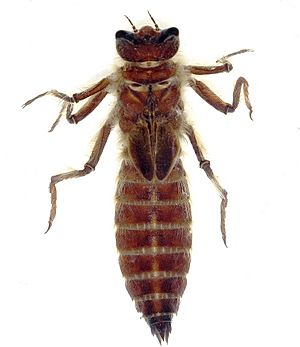Neopetalia punctata facts for kids
Quick facts for kids Neopetalia punctata |
|
|---|---|
 |
|
| Nymph of Neopetalia punctata | |
| Conservation status | |
| Scientific classification |
The Neopetalia punctata is a special kind of dragonfly. It's the only member of its family, called Neopetaliidae. This means it's quite unique!
You can only find this amazing dragonfly in two countries: Argentina and Chile. When an animal or plant is found only in one specific area, we say it is endemic to that place.
Contents
What is a Dragonfly?
Dragonflies are beautiful insects with two pairs of strong, clear wings. They are known for their amazing flying skills! Dragonflies are often found near water, like ponds, lakes, rivers, or swamps. They are very old insects, having been around for millions of years.
How Dragonflies Fly
Dragonflies are super fast and can even fly backwards! They can hover in the air, just like a helicopter. Their four wings can move separately, which gives them incredible control. This helps them catch their food and escape from predators.
Where Does the Neopetalia punctata Live?
As we mentioned, the Neopetalia punctata lives in parts of Argentina and Chile. These areas often have different types of water bodies, which are perfect homes for dragonflies. They need clean water for their young to grow.
Dragonfly Habitats
Dragonflies love places with lots of plants around the water. These plants give them places to rest, hunt, and lay their eggs. The specific places where Neopetalia punctata lives might include forests with streams or open areas with ponds.
What Does This Dragonfly Look Like?
While we don't have all the details about the adult Neopetalia punctata, most dragonflies have large, compound eyes that help them see almost all around them. Their bodies are long and slender. The picture in the box shows a young Neopetalia punctata, called a nymph. Nymphs look very different from adult dragonflies.
Dragonfly Colors
Many dragonflies have bright, shiny colors like blue, green, red, or yellow. These colors can help them attract a mate or blend in with their surroundings.
What Do Dragonflies Eat?
Dragonflies are expert hunters! They eat other insects, especially mosquitoes and flies. They catch their prey while flying, using their legs like a basket. This makes them very helpful insects because they help control populations of annoying bugs.
How Dragonflies Hunt
Dragonflies have excellent eyesight and can spot tiny insects from far away. They are very quick and can snatch their prey right out of the air. Both adult dragonflies and their young nymphs are predators.
The Life Cycle of a Dragonfly
Dragonflies have a fascinating life cycle that involves living in water for part of their lives.
Eggs and Nymphs
A female dragonfly lays her eggs in or near water. When the eggs hatch, tiny creatures called nymphs (or larvae) emerge. The nymph of Neopetalia punctata is shown in the picture. These nymphs live underwater for months, or even years! They breathe using gills and eat small aquatic insects or even tiny fish.
Growing Up
As the nymph grows, it sheds its skin many times. This process is called molting. When it's ready to become an adult, the nymph crawls out of the water, often onto a plant stem.
Adult Dragonflies
Once out of the water, the nymph's skin splits open, and the adult dragonfly emerges. Its wings unfold and harden, and then it takes its first flight. Adult dragonflies live for only a few weeks or months. Their main job is to find a mate and lay eggs, starting the cycle all over again.
Is Neopetalia punctata in Danger?
The conservation status of Neopetalia punctata is listed as "Data Deficient" (DD). This means scientists don't have enough information to know if it's endangered or not. More research is needed to understand how many of these dragonflies exist and what threats they might face.
Why is Data Important?
Knowing how many animals there are and where they live helps scientists protect them. If a species is "Data Deficient," it means we need to learn more about it to make sure it stays safe in the future.
See also
 In Spanish: Neopetalia punctata para niños
In Spanish: Neopetalia punctata para niños


